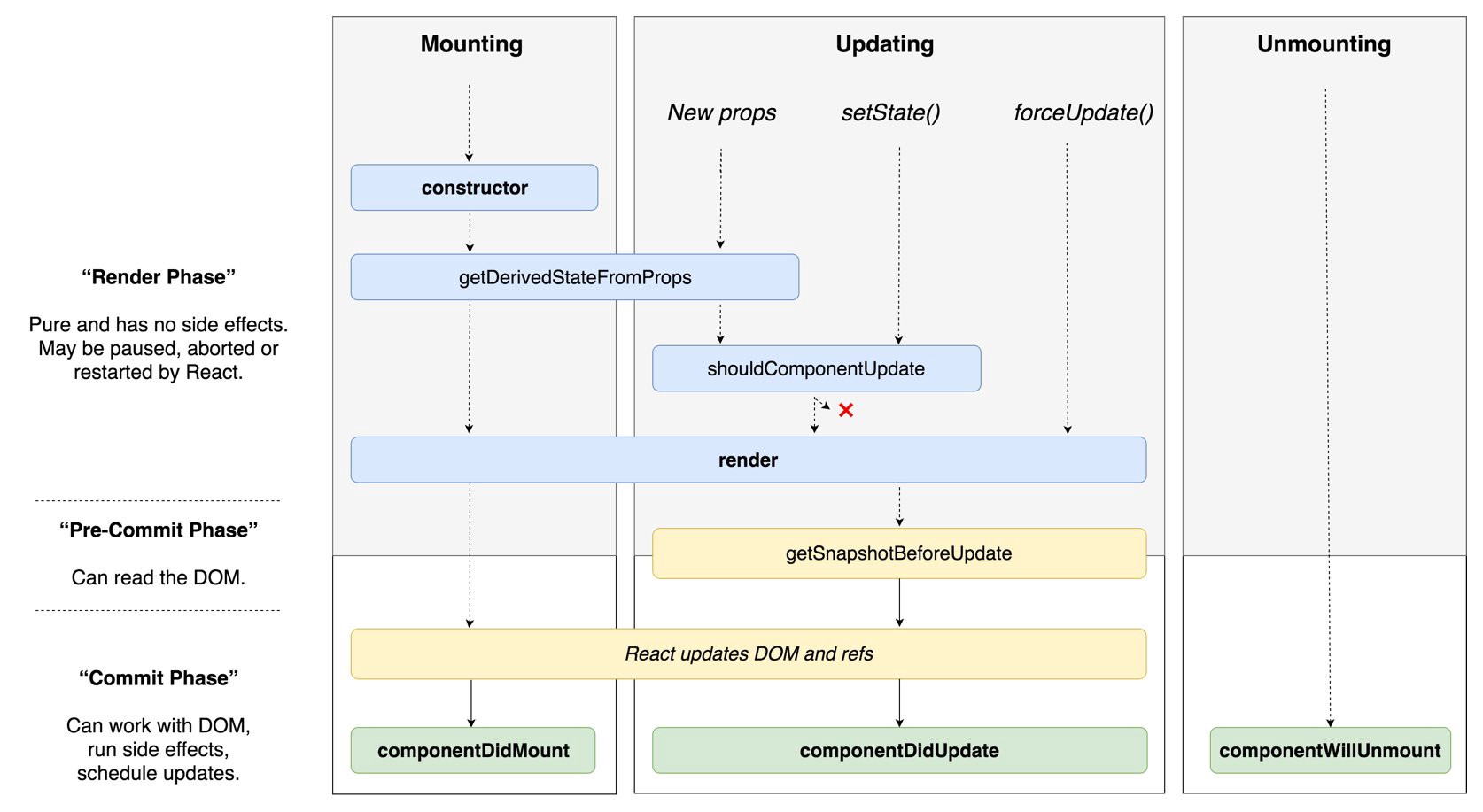LifeCycle

import React, { Component } from 'react';
import PropTypes from 'prop-types';
export default class Basic extends Component {
static propTypes = {
name: PropTypes.string.isRequired,
birth: PropTypes.number.isRequired,
lang: PropTypes.string,
};
static defaultProps = {
lang: 'Javascript',
};
static contextTypes = {
router: PropTypes.object.isRequired,
};
state = {
hidden: false,
};
componentWillMount() {
console.log('componentWillMount');
}
componentDidMount() {
console.log('componentDidMount');
}
componentWillReceiveProps(nextProps) {
console.log('componentWillReceiveProps');
}
shouldComponentUpdate(nextProps, nextState) {
console.log('shouldComponentUpdate');
return true / false;
}
componentWillUpdate(nextProps, nextState) {
console.log('componentWillUpdate');
}
componentDidUpdate(prevProps, prevState) {
console.log('componentDidUpdate');
}
componentWillUnmount() {
console.log('componentWillUnmount');
}
onClickButton = () => {
this.setState({ hidden: true });
this.refs.hide.disabled = true;
}
render() {
return (
<div>
<span>저는 {this.props.lang} 전문 {this.props.name}입니다!</span>
{!this.state.hidden && <span>{this.props.birth}년에 태어났습니다.</span>}
<button onClick={this.onClickButton} ref="hide">숨기기</button>
<button onClick={this.context.router.goBack}>뒤로</button>
</div>
);
}
}리액트 17부터는 componentWillMount, componentWillUpdate, componentWillReceiveProps 라이프 사이클이 deprecated 된다.
Mount
컴포넌트가 처음 실행될 때 그것을 Mount라고 표현한다. 컴포넌트가 시작되면 우선 context, defaultProps와 state를 저장한다. 그 후에 componentWillMount 메소드를 호출한다. 그리고 render로 컴포넌트를 DOM에 부착한 후 Mount가 완료된 후 componentDidMount가 호출된다.
주의할 점은, componentWillMount에서는 props나 state를 바꾸면 안 된다. Mount 중이기 때문이죠. 그리고 아직 DOM에 render하지 않았기 때문에 DOM에도 접근할 수 없다.
componentDidMount에서는 DOM에 접근할 수 있다. 그래서 여기에서는 주로 AJAX 요청을 하거나, setTimeout, setInterval같은 행동을 한다.
- state, context, defaultProps 저장
- componentWillMount
- render
- componentDidMount
Props Update
props가 업데이트될 때의 과정입니다. 업데이트되기 전에 업데이트가 발생하였음을 감지하고, componentWillReceiveProps 메소드가 호출된다. 그 후 shouldComponentUpdate, componentWillUpdate가 차례대로 호출된 후, 업데이트가 완료(render)되면 componentDidUpdate가 된다. 이 메소드들은 첫 번째 인자로 바뀔 props에 대한 정보를 가지고 있습니다. componentDidUpdate만 이미 업데이트되었기 때문에 바뀌기 이전의 props에 대한 정보를 가지고 있다.
shouldcomponentUpdate에서는 아직 render하기 전이기 때문에 return false를 하면 render을 취소할 수 있습니다. 주로 여기서 성능 최적화를 한다. 쓸데없는 update가 일어나면 여기서 걸러낸다.
주의사항이 있는데, componentWillUpdate에서는 state를 바꿔서는 안 된다. 아직 props도 업데이트하지 않았으므로 state를 바꾸면 또 shouldComponentUpdate가 발생한다. componentDidUpdate에서는 render이 완료되었기 때문에 DOM에 접근할 수 있다.
- componentWillReceiveProps
- shouldComponentUpdate
- componentWillUpdate
- render
- componentDidUpdate
State Update
setState 호출을 통해 state가 업데이트될 때의 과정이다. props update와 과정이 같지만, componentWillReceiveProps 메소드는 호출되지 않는다. 그리고 메소드의 두 번째 인자로는 바뀔 state에 대한 정보를 가지고 있다. componentDidUpdate는 두 번째 인자로 바뀌기 이전의 state에 대한 정보를 가지고 있다.
- shouldComponentUpdate
- componentWillUpdate
- render
- componentDidUpdate
Unmount
컴포넌트가 제거되는 것은 Unmount라고 표현한다. 더는 컴포넌트를 사용하지 않을 때 발생하는 이벤트가 있습니다. componentWillUnmount가 그것이다. componentDidUnmount는 없다. 이미 제거된 컴포넌트에서 이벤트를 발생시킬 수는 없다. componentWillMount에서 주로 연결했던 이벤트 리스너를 제거하는 등의 여러 가지 정리 활동을 한다.
- componentWillUnmount
Error
에러 발생 시를 위한 componentDidCatch도 있다. 리액트 16에서 추가되었다.
componentDidCatch(error, info) {
console.error(error, info);
}getDerivedStateFromProps
리액트 16에서 추가된 라이프사이클이다. props가 바뀌면 그에 따라 state도 같이 바꾼다. 예를 들어 props.a가 10이고 derivedA state를 props.a의 10배로 설정해두었다면 derivedState는 기본적으로 100이 된다. props.a가 11이 되었을 때 derivedA는 110으로 따라서 변경된다.
출처
https://www.zerocho.com/category/React/post/579b5ec26958781500ed9955
